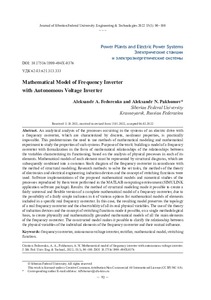Показать сокращенную информацию
Математическая модель преобразователя частоты с автономным инвертором напряжения
| Автор | Федоренко, А. А. | ru_RU |
| Автор | Пахомов, А. Н. | ru_RU |
| Автор | Fedorenko, Aleksandr A. | en |
| Автор | Pakhomov, Aleksandr N. | en |
| Дата внесения | 2022-03-16T06:04:54Z | |
| Дата, когда ресурс стал доступен | 2022-03-16T06:04:54Z | |
| Дата публикации | 2022-02 | |
| URI (для ссылок/цитирований) | https://elib.sfu-kras.ru/handle/2311/145389 | |
| Аннотация | Аналитический анализ процессов, протекающих в системах электропривода с преобразователем частоты, которые характеризуются дискретными, нелинейными свойствами, практически невозможен. Это предопределяет необходимость использования для изучения свойств таких систем методов математического моделирования и математического эксперимента. Цель работы – построение модели преобразователя частоты с формализацией в виде математических соотношений взаимосвязей между переменными, характеризующими его функционирование, на основе анализа физических процессов в каждом его элементе. Математические модели каждого элемента необходимо представить структурными схемами, которые в дальнейшем объединяются в общую структурную схему преобразователя частоты в соответствии с методом структурного моделирования. Для решения поставленных задач использовались методы теории электроники и электротехники, индукционных устройств и понятия коммутационных функций. Программные реализации предлагаемых математических моделей и численные исследования воспроизводимых ими процессов выполнены в вычислительной среде MATLAB (пакет прикладных программ SIMULINK). Метод структурного моделирования позволил создать достаточно универсальный и гибкий вариант полной математической модели преобразователя частоты благодаря возможности достаточно простого включения в нее различных вариантов математических моделей элементов, входящих в конкретный реальный преобразователь частоты. При этом полученная модель сохраняет топологию реального преобразователя частоты и наблюдаемость всех его реальных физических переменных. Использование теории индукционных устройств и понятия коммутационных функций дало возможность на единой методологической основе создать физически и математически обоснованные математические модели всех основных элементов преобразователя частоты. Построенная модель позволяет прояснить взаимосвязи между физическими переменными отдельных элементов преобразователя частоты и их взаимное влияние | ru_RU |
| Аннотация | An analytical analysis of the processes occurring in the systems of an electric drive with a frequency converter, which are characterized by discrete, nonlinear properties, is practically impossible. This predetermines the need to use methods of mathematical modeling and mathematical experiment to study the properties of such systems. Purpose of the work: building a model of a frequency converter with formalization in the form of mathematical relationships of the relationships between the variables characterizing its functioning, based on the analysis of physical processes in each of its elements. Mathematical models of each element must be represented by structural diagrams, which are subsequently combined into a common block diagram of the frequency converter in accordance with the method of structural modeling. Research methods: to solve the set tasks, the methods of the theory of electronics and electrical engineering, induction devices and the concept of switching functions were used. Software implementations of the proposed mathematical models and numerical studies of the processes reproduced by them were performed in the MATLAB computing environment (SIMULINK application software package). Results: the method of structural modeling made it possible to create a fairly universal and flexible version of a complete mathematical model of a frequency converter, due to the possibility of a fairly simple inclusion in it of various options for mathematical models of elements included in a specific real frequency converter. In this case, the resulting model preserves the topology of a real frequency converter and the observability of all its real physical variables. The use of the theory of induction devices and the concept of switching functions made it possible, on a single methodological basis, to create physically and mathematically grounded mathematical models of all the main elements of the frequency converter. The constructed model makes it possible to clarify the relationship between the physical variables of the individual elements of the frequency converter and their mutual influence | en |
| Язык | ru | ru_RU |
| Издатель | Сибирский федеральный университет. Siberian Federal University | en |
| Тема | преобразователь частоты | ru_RU |
| Тема | автономный инвертор напряжения | ru_RU |
| Тема | выпрямитель | ru_RU |
| Тема | математическая модель | ru_RU |
| Тема | коммутационная функция | ru_RU |
| Тема | frequency converter | en |
| Тема | autonomous voltage inverter | en |
| Тема | rectifier | en |
| Тема | mathematical model | en |
| Тема | switching function | en |
| Название | Математическая модель преобразователя частоты с автономным инвертором напряжения | ru_RU |
| Альтернативное название | Mathematical Model of Frequency Inverter with Autonomous Voltage Inverter | en |
| Тип | Journal Article | ru_RU |
| Контакты автора | Федоренко, А. А.: Сибирский федеральный университет Российская Федерация, Красноярск | ru_RU |
| Контакты автора | Пахомов, А. Н.: Сибирский федеральный университет Российская Федерация, Красноярск | ru_RU |
| Контакты автора | Fedorenko, Aleksandr A.: Siberian Federal University Krasnoyarsk, Russian Federation | en |
| Контакты автора | Pakhomov, Aleksandr N.: Siberian Federal University Krasnoyarsk, Russian Federation; APahomov@sfu-kras.ru | en |
| Страницы | 90–100 | ru_RU |
| DOI | 10.17516/1999-494X-0376 | |
| Журнал | Journal of Siberian Federal University. Engineering & Technologies 2022; Журнал Сибирского федерального университета 2022 15 (1) | en |

